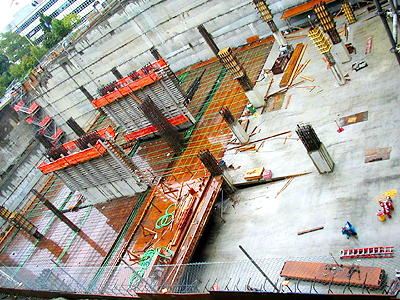|
by Eric
Englund

As
the tech meltdown continues, there is more to this story
than the spectacular collapse of the tech-laden NASDAQ
stock index. Indeed, manufacturers of computer and telecommunications
equipment have posted terrible financial results as have
many wireless telecommunications companies. As Greg Ip
wrote in his August 20, 2001 page 1 Wall Street Journal article
("A year Into Slowdown, Economy's Last Pillars Show
Signs of Stress"), even commercial real estate developers
are being stung right across the street from my office
in downtown Bellevue, WA (more on this later). How could
so many intelligent businessmen make such huge errors in
such a compressed timeframe? One answer has to do with
the hyperreality created by the three-way collision of
our left-leaning educational establishment, the internet,
and inflationist Federal Reserve policy. From this collision
emerged "Homo Digitus": the new cyber-man who
had to be wired twenty-four hours a day, seven days a week.
The following is a brief story of this mythical man and
his monument to malinvestment in Bellevue, WA (the Bellevue
Technology Tower).
In
reading Murray Rothbard's wonderful book Education,
Free & Compulsory, it became all the more clear
to me how thoroughly left-wing and pro central government
the teaching profession has become. Heck, in public school,
I was "taught" that FDR personally rescued our
country from the ravages of the capitalist-induced depression.
Additionally, my teachers "taught" me how to
become a good environmentalist through having us parrot
Woodsy the Owl's wise words of "give a hoot don't
pollute". In looking back at my public-school education,
I have no doubt that I was being indoctrinated to become
a good citizen. If this sounds implausible, Murray Rothbard's
aforementioned book contains a wonderful quote from the
great philosopher Herbert Spencer (as follows):
For
what is meant by saying that a government ought to educate
the people? Why should people be educated? What is education
for? Clearly, to fit the people for social life - to make
them good citizens. And who is to say what are good citizens?
The government: there is no other judge. And who is to
say how these good citizens may be made? The government:
there is no other judge. Hence the proposition is convertible
into this - a government ought to mold children
into good citizens...It must first form for itself a definite
conception of a pattern citizen; and, having done this,
must elaborate such system of discipline as seems best
calculated to produce citizens after that pattern. This
system of discipline it is bound to enforce to the uttermost.
For if it does otherwise, it allows men to become different
from what in its judgment they should become, and therefore
fails in that duty it is charged to fulfill.
With
this being said, it is important to understand that there
is a general belief that mankind is moldable and can be
transformed. This subtly Maoist mindset permeates the teaching
profession. Indeed, it even appears that this mindset permeated
high-tech companies throughout the U.S.
In
an accident of history, the internet emerged and was gaining
widespread popularity just at the same time the Federal
Reserve was inflating the money supply in dramatic fashion
(in the late 1990s). In particular, the Federal Reserve
inflated the money stock after the Long Term Capital Management
debacle (in 1998) and then again (in 1999) in anticipation
of a Y2K disaster. As a result of this loose-money policy
(by the Federal Reserve), banks, venture capitalists, and
many individual investors were awash in cash and, thus,
willing to fund any scheme involving the internet. Internet
IPOs were abound and internet stock valuations were heading
to the moon. Not much longer after the rate of increase
in the money stock peaked in 1999 (as measured by MZM,
M2, and M3) the NASDAQ peaked in March of 2000. In August
of 2000, construction of the Bellevue Technology Tower
began in earnest.
With
investors awash in cash (thanks to the Federal Reserve),
a hyperreality emerged in which the internet was credited
with playing the central role in the seemingly effortless
creation of wealth (i.e. via surreally high valuations
for internet and related tech stocks). Undoubtedly, a new
hyperreal man had emerged in which virtually any information
could be transformed into money. The true believers, in
this alchemy of the internet, believed they had transformed
into a new man (Homo Digitus) fit for the wonders of wealthy
cyber-living.
For
others to follow, and to be transformed, it would be necessary
for the masses (and for high-tech corporate leaders) to
share the vision of an internet-transformed cyber life.
If teachers can mold students into good citizens, then
why can't a person mold himself into Homo Digitus? With
the help of Palm Pilots, powerful PCs, and internet accessible
cell phones, "information" could be turned into
money (especially through day trading on the stock market).
With a fury, high-tech corporate America responded by producing
a myriad of electronic gizmos and by placing millions of
miles of fiber optic cable underground. High-tech corporate
America's response reflected a faith in man's ability to
transform.
A
natural response, to markedly increased business activity,
is to construct new buildings to house new companies.
Here in downtown Bellevue, WA, three notable construction
projects began last year: The Summit project ($100 million
range), Lincoln Square ($350 million), and Bellevue Technology
Tower ($118 million). In particular, the Bellevue Technology
Tower was designed to house the companies of the future.
Homo Digitus could come to work in a high-tech building
with such features as:
- Abundant
space for transformers and associated switchgear
- Abundant
space for back-up generators
- Large
connectivity spaces
- Redundant
conduit entries and cable risers
- Large
radio rooms for satellite electronics

The
Bellevue Technology Tower was to be a glorious new building
fit for our new cyber-world.
As
Greg Ip wrote in his Wall Street Journal article,
the Bellevue Technology Tower project has been halted "...with
only the parking garage completed..." Mr. Ip's view
is that this ill-fated construction project was a victim
of the dot.com/high-tech crash. Naturally, the article
implies that this project may be resurrected if the Federal
Reserve's interest rate cuts perform their magic (perhaps
the Fed's .25% rate cut on August 21, 2001 will be enough
to get the Bellevue Technology Tower project going again?).
There is a better explanation as to what happened to
the Bellevue Technology Tower. It ties together the Fed,
the internet, and the illusion that humans are moldable
as plastic. The Federal Reserve's aforementioned easy-money
policy made it appear that money could be plucked effortlessly
from cyberspace. After all, the Federal Reserve does
create money out of thin air. This money creation lead
to a Fed-induced mania revolving around the internet
and its promise to transform mankind. Dr. Paul A. Cantor
does an excellent job of describing the connection between
hyperreality (mania) and the Federal Reserve.
If
modernity is characterized by a loss of sense of the real,
this fact is connected to what has happened to money in
the twentieth century. Everything threatens to become unreal
once money ceases to be real...That fact is ultimately
to be traced to the biggest counterfeiter of them all -
the government and its printing press... Inflation is that
moment when as a result of government action the distinction
between real money and fake money begins to dissolve. That
is why inflation has such a corrosive effect on society.
Money is one of the primary measures of value in any society,
perhaps the primary one, the principal repository
of value. As such, money is a central source of stability,
continuity, and coherence in any community. Hence to tamper
with the basic money supply is to tamper with a community's
sense of value. By making money worthless, inflation threatens
to undermine and dissolve all sense of value in a society.
So
there you have it. Creating money out of thin air can dissolve
all sense of value. The Federal Reserve induced the internet
mania. Moreover, especially in a mania, people can even
be fooled to believe that mankind can remake himself (once
again an unfortunate vestige of Maoism and embraced, perhaps
unwittingly, by educators). Correspondingly, in the highly
tangible world of construction, an easy-money policy (by
the Federal Reserve) can fool a developer into constructing
a building that should not have been built in the first
place.
The
collapse of the dot.com/high-tech bubble began by the second
quarter of 2000. By this time, there had been a long fall
in the rate of increase in the money supply. The bubble
had run out of fuel yet construction on the Bellevue Technology
Tower was underway (by the summer of 2000). The "medicine" of
lower interest rates (i.e. more money creation) Alan Greenspan
is currently dispensing to the American economy, is the
exact same medicine that prompted the Bellevue Technology
Tower's developer to undertake this unnecessary project
in the first place. Bellevue has its monument to Homo Digitus
whose myth emerged as a result of the hyperreality spawned
by the Federal Reserve. This monument is not a completed
garage as reported by Mr. Ip (it is actually partially
complete). Fittingly, the monument to Homo Digitus is a
huge hole in the ground that I can see from my office window.
Really!
August
24, 2001 |

